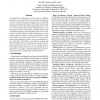Free Online Productivity Tools
i2Speak
i2Symbol
i2OCR
iTex2Img
iWeb2Print
iWeb2Shot
i2Type
iPdf2Split
iPdf2Merge
i2Bopomofo
i2Arabic
i2Style
i2Image
i2PDF
iLatex2Rtf
Sci2ools
ICECCS
1996
IEEE
1996
IEEE
Dynamically Reconfigurable Embedded Software - Does It Make Sense?
A dynamically reconfigurable real-time software (DRRTS) paradigm can be used effectively in the design of embedded systems to provide many major advantages over conventional software development techniques. The benefits include rapid development which reduces development time and cost, ability to easily upgrade and maintain embedded software, and both analytic and practical tools for automated analysis and systematic fine tuning of the embedded system. Our current research is founded upon the Chimera Methodology, which demonstrated the feasibility of using dynamically reconfigurable software to control robots. However, there are still many design challenges in order to use it in an embedded system, which has less flexibility, severe limits on memory and CPU bandwidth, and more rigid timing constraints and reliability specifications. We have several ongoing projects which address some of the issues, in a strive towards the overall objective of creating a software infrastructure for dev...
| Added | 07 Aug 2010 |
| Updated | 07 Aug 2010 |
| Type | Conference |
| Year | 1996 |
| Where | ICECCS |
| Authors | David B. Stewart, Gaurav Arora |
Comments (0)

